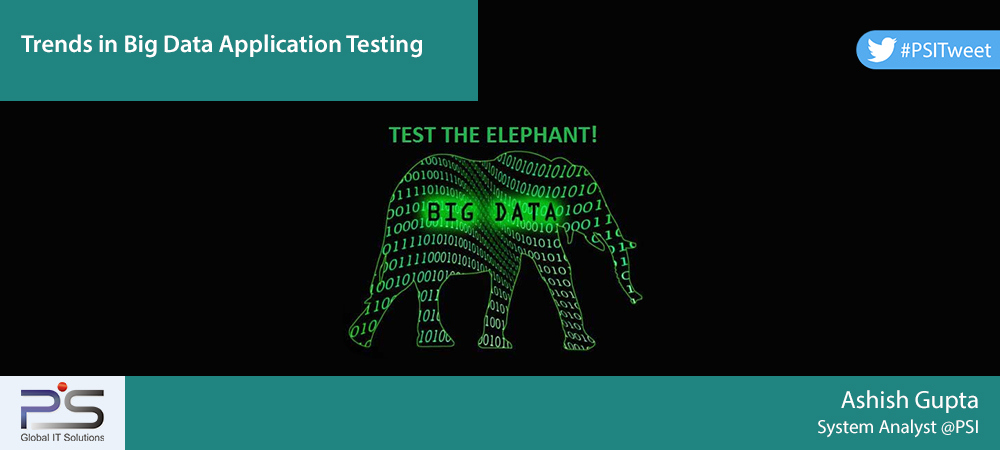
A recent IDC report states that Big Data technology and services market represents a fast-growing multibillion-dollar worldwide opportunity. Further, it forecasts that the Big Data technology and services market will grow at a 26.4% compound annual growth rate to $41.5 billion through 2018, or about six times the growth rate of the overall information technology market.
Big Data applications act as a medium to capture, store, search, and analyse the data by the organisations. These applications shouldn’t be compared with traditional applications like client-server applications and websites as these differ both in nature and complexity. The testing process for Big Data applications should necessarily be developed with these challenges in mind.
Big Data Test Approach
As a software tester, it is required to have a clear understanding of Big Data. Big Data generates value from the processing of large quantities of data that cannot be analysed with the traditional computing techniques. Testing of large datasets involves various techniques, tools and frameworks to process. Big data majorly relate to data creation, storage, retrieval and analysis that is remarkable in terms of variety, volume, and velocity.
The major data aspects to be considered while planning for testing the big data applications are:
- Volume and speed of data generation
- Data source and format
- Selection of test data
- Individual module testing
- End to end application testing
- Reliability and performance testing
Latest Trends
Improve efficiency with live data integration testing: Big data application requires LIVE data feed and real-time analysis. The varieties of data sources make LIVE integration a complex task. The objective of Data Integration testing is to verify that data moves as expected. At a high level, data integration can be divided into the following categories:
Reduce downtime by instant application deployment testing: Big Data applications are developed for predictive analytics. These applications have a dependency on data collection and deployment. The results from big data are the key factors for business decisions and the instant deployment is very crucial for business dynamics. It makes the testing of the application and the data essential prior to the live deployment.
- Data Warehouse and BI Testing
- Data Migration Testing
- Master Data Management Testing
- Data Consolidation Testing
- Data Synchronization Testing
Application performance testing: Performance of any application is a critical factor, so is the case with big data applications. These applications work with LIVE data and provide analytical insights of such complex data. The performance testing of these applications is essential to support scalability.
Some of the areas where performance issues can arise are inequalities in a redundant shuffle, input splits and sorts, moving most of the aggregation computations to reduce process which can be done. These performance issues can be eliminated by carefully designing the system architecture and doing the performance test to identify the bottlenecks. Utilities like Hadoop performance monitoring tool can be used to capture the performance metrics like job completion time, throughput etc.
Ensure scalability: It is another very important trend in testing Big Data applications due to huge data volume. To make sure that the application supports the increasing load, its architecture should be tested properly with proper data samples. These applications should ensure the balance between making it scalable without compromising on performance.One can avoid scalability issues entirely by using smart test data samples to test the framework of the application at important moments.
Functional consistency: Access to a variety of data sets is what makes Big Data worthwhile. An enterprise can produce unlimited possibilities with the right kind of knowledge, but when the results attained over the time with Big Data applications and projecting analytics turn out to be inconsistent then it could become a case of hit or miss for the association. Proper testing allows them to define the variability accurately and removes uncertainty.
Security Testing: Big data applications work on data from various sources so security testing is another important trend in all big data applications. The security of this large volume of data should be ensured while developing the application. Proper testing has to be done to make sure that confidential data, processed on a big data platform, should not be exposed in public.
Failover Testing: The Hadoop Architecture consists of a name node and attached many data nodes hosted and connected on various server machines. There are chances of name or data node or network failure. The key area is to validate the recovery method and check that data processing happens seamlessly when switched to other data nodes.
Automation Testing: Automation Testing can be used to test the Big Data regression test suite that will be used multiple times due to periodical updating of databases. Hence, an automated regression test suite should be executed after release to speed up the test coverage and save time during Big Data validations.
The major dimensions and trends in big data application testing have been discussed above. Hope this act as a base to get started with Big Data Testing. Big Data is quickly emerging to be a leading technology domain to watch out for. It is indisputably one of the technologies that will define the future and the way the human race makes decisions and defines growth trends.A recent IDC report states that Big Data technology and services market represents a fast-growing multibillion-dollar worldwide opportunity. Further, it forecasts that the Big Data technology and services market will grow at a 26.4% compound annual growth rate to $41.5 billion through 2018, or about six times the growth rate of the overall information technology market.
Big Data applications act as a medium to capture, store, search, and analyse the data by the organisations. These applications shouldn’t be compared with traditional applications like client-server applications and websites as these differ both in nature and complexity. The testing process for Big Data applications should necessarily be developed with these challenges in mind.
Big Data Test Approach
As a software tester, it is required to have a clear understanding of Big Data. Big Data generates value from the processing of large quantities of data that cannot be analysed with the traditional computing techniques. Testing of large datasets involves various techniques, tools and frameworks to process. Big data majorly relate to data creation, storage, retrieval and analysis that is remarkable in terms of variety, volume, and velocity.
The major data aspects to be considered while planning for testing the big data applications are:
- Volume and speed of data generation
- Data source and format
- Selection of test data
- Individual module testing
- End to end application testing
- Reliability and performance testing
Latest Trends
Improve efficiency with live data integration testing: Big data application requires LIVE data feed and real-time analysis. The varieties of data sources make LIVE integration a complex task. The objective of Data Integration testing is to verify that data moves as expected. At a high level, data integration can be divided into the following categories:
Reduce downtime by instant application deployment testing: Big Data applications are developed for predictive analytics. These applications have a dependency on data collection and deployment. The results from big data are the key factors for business decisions and the instant deployment is very crucial for business dynamics. It makes the testing of the application and the data essential prior to the live deployment.
- Data Warehouse and BI Testing
- Data Migration Testing
- Master Data Management Testing
- Data Consolidation Testing
- Data Synchronization Testing
Application performance testing: Performance of any application is a critical factor, so is the case with big data applications. These applications work with LIVE data and provide analytical insights of such complex data. The performance testing of these applications is essential to support scalability.
Some of the areas where performance issues can arise are inequalities in a redundant shuffle, input splits and sorts, moving most of the aggregation computations to reduce process which can be done. These performance issues can be eliminated by carefully designing the system architecture and doing the performance test to identify the bottlenecks. Utilities like Hadoop performance monitoring tool can be used to capture the performance metrics like job completion time, throughput etc.
Ensure scalability: It is another very important trend in testing Big Data applications due to huge data volume. To make sure that the application supports the increasing load, its architecture should be tested properly with proper data samples. These applications should ensure the balance between making it scalable without compromising on performance.One can avoid scalability issues entirely by using smart test data samples to test the framework of the application at important moments.
Functional consistency: Access to a variety of data sets is what makes Big Data worthwhile. An enterprise can produce unlimited possibilities with the right kind of knowledge, but when the results attained over the time with Big Data applications and projecting analytics turn out to be inconsistent then it could become a case of hit or miss for the association. Proper testing allows them to define the variability accurately and removes uncertainty.
Security Testing: Big data applications work on data from various sources so security testing is another important trend in all big data applications. The security of this large volume of data should be ensured while developing the application. Proper testing has to be done to make sure that confidential data, processed on a big data platform, should not be exposed in public.
Failover Testing: The Hadoop Architecture consists of a name node and attached many data nodes hosted and connected on various server machines. There are chances of name or data node or network failure. The key area is to validate the recovery method and check that data processing happens seamlessly when switched to other data nodes.
Automation Testing: Automation Testing can be used to test the Big Data regression test suite that will be used multiple times due to periodical updating of databases. Hence, an automated regression test suite should be executed after release to speed up the test coverage and save time during Big Data validations.
The major dimensions and trends in big data application testing have been discussed above. Hope this act as a base to get started with Big Data Testing. Big Data is quickly emerging to be a leading technology domain to watch out for. It is indisputably one of the technologies that will define the future and the way the human race makes decisions and defines growth trends.[:]








